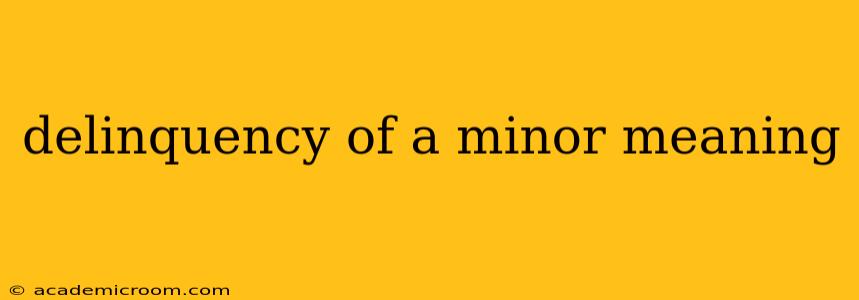Delinquency of a minor refers to acts committed by a child or adolescent that would be considered crimes if committed by an adult. It's a crucial legal concept that distinguishes between children who break the law and adults who do. Understanding its meaning is vital for parents, educators, and anyone working with young people. This article will delve into the definition, implications, and common questions surrounding juvenile delinquency.
What does delinquency of a minor mean in legal terms?
In legal terms, delinquency of a minor signifies that a child or young person, typically below the age of 18 (this age varies slightly by jurisdiction), has engaged in behavior violating the law. This behavior isn't treated the same as adult crime; the focus shifts from punishment to rehabilitation and reform. The legal system recognizes that minors are still developing and may lack the full understanding of consequences that adults possess. Therefore, the consequences for delinquent acts are generally different from those for adult crimes.
What are some examples of acts considered delinquency?
The specific acts considered delinquent vary depending on the jurisdiction and the minor's age. However, common examples include:
- Property crimes: Theft, vandalism, arson, burglary.
- Violent crimes: Assault, battery, robbery.
- Status offenses: These are acts illegal only because of the minor's age, such as truancy (skipping school), running away from home, or violating curfew. Adults cannot be charged with status offenses.
- Drug-related offenses: Possession, use, or sale of illegal substances.
How is delinquency different from criminal behavior?
While both involve breaking the law, the key distinctions lie in:
- Legal proceedings: Juvenile delinquency cases are handled in juvenile courts, which emphasize rehabilitation and treatment rather than punishment. Adult criminal cases go through adult courts with a focus on punishment and incarceration.
- Records: Juvenile records are typically sealed, protecting the minor's future opportunities. Adult criminal records are permanent and can significantly impact employment and other aspects of life.
- Sentencing: Juvenile court sentences focus on rehabilitation, such as probation, counseling, community service, or placement in a juvenile detention facility. Adult court sentences often involve jail time, fines, and other penalties.
What are the consequences of juvenile delinquency?
The consequences of juvenile delinquency can range from minor sanctions to significant interventions, depending on the severity of the offense and the minor's history. Possible consequences include:
- Probation: Supervision by a probation officer.
- Community service: Unpaid work benefiting the community.
- Restitution: Repaying victims for damages or losses.
- Counseling or therapy: Addressing underlying issues contributing to delinquency.
- Placement in a juvenile detention facility: A secure facility for minors who have committed serious offenses.
What are the factors that contribute to juvenile delinquency?
Multiple factors can contribute to juvenile delinquency, including:
- Family environment: Lack of parental supervision, family conflict, abuse, or neglect.
- Peer influence: Association with delinquent peers.
- Socioeconomic factors: Poverty, lack of opportunities, and exposure to violence.
- School issues: Academic difficulties, truancy, and bullying.
- Mental health issues: Depression, anxiety, or other mental health conditions.
How can juvenile delinquency be prevented?
Preventing juvenile delinquency requires a multi-pronged approach focusing on:
- Strengthening families: Providing support services for families, promoting positive parenting skills, and addressing domestic violence.
- Improving schools: Creating supportive school environments, addressing academic challenges, and reducing bullying.
- Providing access to resources: Ensuring access to healthcare, mental health services, and recreational opportunities.
- Community involvement: Engaging communities in crime prevention efforts.
Understanding juvenile delinquency requires recognizing the complexities of adolescent development and the interplay of various factors. The focus should always remain on rehabilitation and providing the youth with the opportunity to become productive members of society. This requires a collaborative effort from families, schools, communities, and the juvenile justice system.
